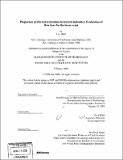| dc.contributor.advisor | Greg Hirth. | en_US |
| dc.contributor.author | Mehl, Luc | en_US |
| dc.contributor.other | Woods Hole Oceanographic Institution. | en_US |
| dc.date.accessioned | 2008-11-07T18:50:06Z | |
| dc.date.available | 2008-11-07T18:50:06Z | |
| dc.date.issued | 2008 | en_US |
| dc.identifier.uri | http://hdl.handle.net/1721.1/42997 | |
| dc.description | Thesis (S.M.)--Joint Program in Marine Geology and Geophysics (Massachusetts Institute of Technology, Dept. of Earth, Atmospheric, and Planetary Sciences; and the Woods Hole Oceanographic Institution), 2008. | en_US |
| dc.description | Includes bibliographical references (p. 30-37). | en_US |
| dc.description.abstract | We evaluate the applicability of plagioclase and gabbro flow laws by comparing predicted and observed deformation mechanisms in gabbroic shear zones. Gabbros and layered gabbro mylonites were collected from the Southwest Indian Ridge (SWIR), ODP Hole 735B. Deformation temperatures are constrained by two-pyroxene thermometry, stress is estimated from grain size, and deformation mechanisms are analyzed by microstructure and the presence or absence of a lattice preferred orientation (LPO). Our analyses indicate that mylonite layers deformed at a strain rate in the range of 1012 to 101 s-1, while coarse-grained gabbro deformed at a strain rate of approximately 10-14 to 1013 s-1. Plagioclase in pure plagioclase mylonite layers exhibit strong LPOs indicating they deform by dislocation creep. Plagioclase grain size in mixed plagioclase-pyroxene mylonite layers is finer than in pure plagioclase layers, and depends on the size and proportion of pyroxenes. Progressive mixing of pyroxene and plagioclase within gabbro mylonite layers is accompanied by weakening of the LPO indicating that phase mixing promotes a transition to diffusion creep processes that involve grain boundary sliding. Our results indicate that experimental flow laws are accurate at geologic strain rates, although the strain rate for diffusion creep of fine-grained gabbro may be underestimated. At the conditions estimated for the SWIR crust, our calculations suggest that strain localization leads to a factor of two to four decrease in lower crustal viscosity. Even so, the viscosity of lower gabbroic crust is predicted to be similar to that of dry upper mantle. | en_US |
| dc.description.statementofresponsibility | by Luc Mehl. | en_US |
| dc.format.extent | 66 leaves: | en_US |
| dc.language.iso | eng | en_US |
| dc.publisher | Massachusetts Institute of Technology | en_US |
| dc.rights | M.I.T. theses are protected by
copyright. They may be viewed from this source for any purpose, but
reproduction or distribution in any format is prohibited without written
permission. See provided URL for inquiries about permission. | en_US |
| dc.rights.uri | http://dspace.mit.edu/handle/1721.1/7582 | en_US |
| dc.subject | Earth, Atmospheric, and Planetary Sciences. | en_US |
| dc.subject | Joint Program in Marine Geology and Geophysics. | en_US |
| dc.subject | Woods Hole Oceanographic Institution. | en_US |
| dc.subject.lcsh | Mylonite | en_US |
| dc.title | Plagioclase preferred orientation in the layered mylonites : evaluation of flow laws for the lower crust | en_US |
| dc.type | Thesis | en_US |
| dc.description.degree | S.M. | en_US |
| dc.contributor.department | Joint Program in Marine Geology and Geophysics | en_US |
| dc.contributor.department | Woods Hole Oceanographic Institution | en_US |
| dc.contributor.department | Massachusetts Institute of Technology. Department of Earth, Atmospheric, and Planetary Sciences | |
| dc.identifier.oclc | 237787142 | en_US |
